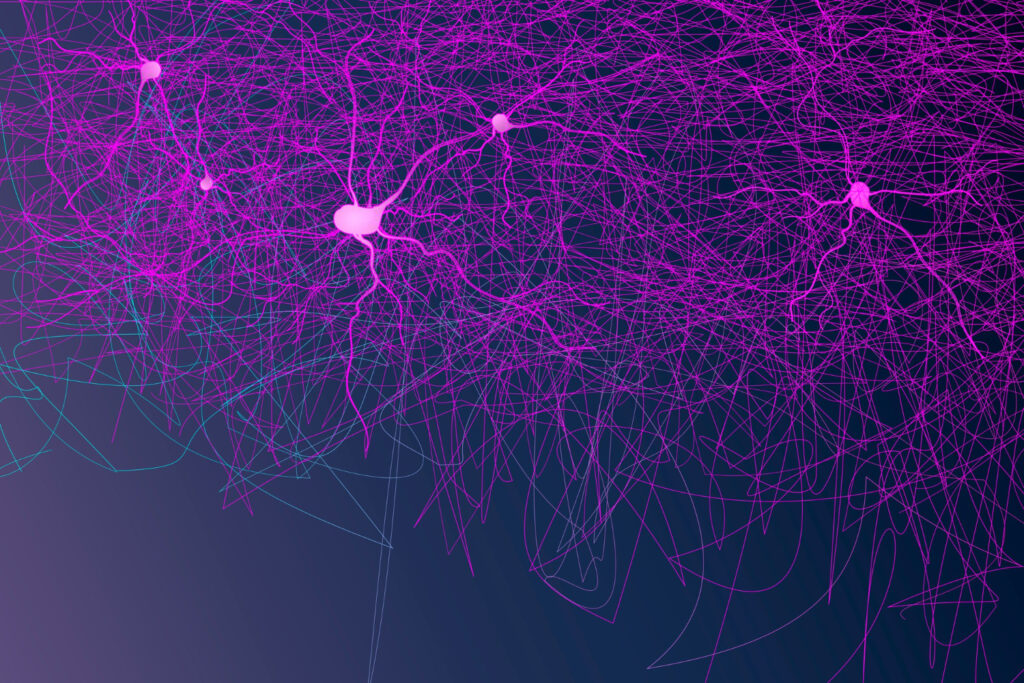This system enables living beings to feel, think, and react. It oversees all life processes and regulates other systems within the body, essentially serving as a command center.
The primary cells of the nervous system are neurons and glial cells. Neurons are specialized for receiving and transmitting electrochemical impulses, while glial cells provide structural support for neural circuits and can also transmit impulses themselves.
The nervous system is one of the first to develop during the formation of a human being and other living organisms.
In humans, its rudiments are present as early as the first month of the embryo's existence, and shortly afterward three brain vesicles develop:
It is how the structure from which the brain develops is created. Further development of the nervous system is extremely rapid and does not end at the moment of birth but lasts even until the age of twenty.

The anatomy of the human nervous system is exceptionally complex, especially since in the human body and other vertebrates there are two such systems, mutually interconnected:
It is also called CNS and consists of the spinal cord and the brain. The spinal cord, which runs along the spine as the name suggests, is made up of gray and white matter. It is responsible for conducting nerve impulses between the brain and the peripheral system and vice versa – 31 pairs of spinal nerves branch off from it. The cerebrum, or brain, is a fragment of the central nervous system in the skull. According to the clinical division, it is made of two hemispheres, the cerebellum and the brain stem.
It consists of 12 pairs of cranial nerves – starting in the brain, extending to the skin of the face, the organs of sight, smell, and hearing, and 31 pairs of spinal nerves – starting from the spinal cord, responsible for sensation in the upper and lower limbs, diaphragm, chest, abdomen, and genitals. The function of the peripheral nervous system is to transmit nerve impulses between the brain and all organs in the body.
In turn, in terms of function, the nervous system can be divided into:
The electrical impulse generated in the axonal hillock is formally known as the action potential of a neuron. Informally, this phenomenon is often referred to as the “shooting” or “firing” of the neuron. It involves a local exchange of electrically charged molecules—ions—between the interior of the cell and its surroundings. Although we are not dealing with an electric wire, we are still witnessing the flow of electric current. From a physics standpoint, electric current refers to the movement of any particles (or molecules) with an electric charge, which includes ions, rather than just electrons in a copper or aluminum wire.
This impulse represents the neuron's “decision” to transmit a signal to the next cell. An action potential is formed when a neuron receives signals from other cells that meet specific criteria. Once generated, the impulse travels along the axon and reaches its end, where it triggers further processes necessary for passing the signal to another cell. Since the axon has branches, a single signal can reach multiple cells if individual axon branches connect with other neurons.
The point of communication between these cells is called a synapse. Statistically, most axonal endings connect with the dendrites of the receiving cell, and the majority of synapses are formed between the axonal ending and the dendritic spine—a specialized protrusion on the dendrite's surface that likely facilitates synapse formation (although not all neurons create dendritic spines).
Thousands of conditions can impact your nerves. A damaged nerve has a problem sending a message. Sometimes it is so impaired that it can’t send or receive a message. Nerve damage can cause numbness, tingling, and pain. Moving the injured area can be difficult or impossible.
The list of diseases related to the nervous system is long, because their symptoms can be very diverse. So it is meaningful to pay attention to your organism.
The basal ganglia are deep within the brain and play a significant role in regulating movement. These nerves create a compound known as dopamine, which is essential in managing many functions, including executive processes and motor control. Although the reason is not yet obvious, sometimes the basal ganglia may get damaged and start to die. The consequence is Parkinson’s disease, as the loss of dopamine slowly impairs essential processes like walking, talking, and memory recall. These outcomes are compounded by the loss of nerves accountable for producing norepinephrine, a pivotal sympathetic nervous system chemical required to control heart rate and blood pressure.

Major nerves extend from the central nervous system to different organs and tissues, each responsible for characteristic functions. Fortunately, the complete manifestation of Bell's palsy is often transient, with many individuals experiencing recovery in the impacted areas within several months. While the exact causes of cranial nerve swelling and Bell's palsy are not always clear, scientists suggest that a recurrent viral infection in the nervous system may trigger an immune response that leads to nerve damage.
Neurons are signaling agents in our bodies but they do not act alone. The axons that carry signals from the cell body of a neuron are covered in myelin sheaths. These are made in the central nervous system by cells called oligodendrocytes, allowing the myelin sheaths to protect and facilitate nerve conduction. In multiple sclerosis, an abnormal immune response in the central nervous system removes the myelin sheath and causes much of the nerve scarring (sclerosis) that gives rise to the disease. Research is underway to treat the condition by encouraging the regeneration of myelin sheaths.
The aging of the body causes changes to occur. This process has a significant impact on the quality of life of older people, in whom it is most visible.
The aging process reduces the number of neurons in the brain. As a result, changes in cognitive functions are observed (impaired memorization and short-term memory). One of the most distinguishing changes in the nervous system is the slowing down of impulse conduction. This is why the time of reflex reactions is prolonged. Older people suffer from a weakening of peripheral sensation and deep sensation.
Here are the most standard general signs of nervous system conditions. Nevertheless, every person can experience them in various ways.
The most common symptoms include:
Of course, not all of them have to be related to diseases. Sometimes, they are caused by diseases of other organs or deficiencies of certain nutrients, so it is worth consulting a doctor if symptoms recur.
Damage to the central nervous system, i.e. the brain and spinal cord, is largely irreversible, which is due to the inaccessibility of these structures for repair cells. Therefore, self-regeneration processes are impossible. Therefore, all diseases and disorders of the CNS have far-reaching effects and can lead to permanent deterioration of quality of life and even death.
Adequate nutrition is essential for the proper functioning of the entire human body, and especially for the nervous system. Many components of the diet, such as water, fatty acids, vitamins, and minerals, regulate the growth, development, and differentiation of cells in the nervous system.
As blood volume decreases due to dehydration, cognitive functions, short-term memory, and the ability to concentrate deteriorate. Even minor dehydration of the body, amounting to 1-2%, can cause general fatigue and impaired concentration or mood changes by weakening the conduction of electrical impulses in the nervous system.
Fatty acids, especially polyunsaturated omega-3 acids, are essential for the construction and development of the brain already in the prenatal period and later throughout life. They play an important role in decreasing oxidative stress. Fatty acids are an anti-inflammatory factor that counteracts the degeneration of nerve cells, i.e. neurons. They affect cognitive performance, neuroplasticity of nerve cells, mood, and stabilization of emotional reactions.
A diet good for the brain must provide vitamins and minerals. Deficiencies of these ingredients are associated with impaired functioning of the nervous system, which can manifest itself in weakness, fatigue, memory disorders, and concentration.
To slow down the neurodegenerative processes of the nervous system, specialists recommend the MIND diet, which is a combination of the recommendations of the Mediterranean diet and the DASH diet.

Lack of sleep is a factor that significantly affects the functioning of the nervous system. Depending on age, the need for sleep is different. Adults should sleep for about 8 hours. In order for sleep to provide regeneration, rest should meet certain rules (sleep hygiene).
The valuable effect of physical activity on the body is undeniable. Exercise has a positive impact on physical and mental health. Physical activity affects the cognitive functioning of people of all ages. It has a neuroprotective effect – it controls neurodegenerative processes. People who practice sports are less exposed to lifestyle diseases and mental disorders and have a greater sense of well-being.
Physical exercise stimulates the release of neurotrophins in the central nervous system. These compounds are responsible for the processes of neurogenesis (the process of formation and differentiation of nerve cells, angiogenesis (the process of formation of capillaries), and synaptogenesis (the process of creating connections between nerve cells). They affect the plasticity of the brain, and regulate the process of differentiation and survival of neurons, thus influencing learning and memory.
Intense and long-term physical exercise results in increased secretion of glucocorticoids, which lower the concentration of BDNF, which results in the inhibition of neurogenesis, reduced brain neuroplasticity, intensified neurodegeneration processes, and increased.
If you notice any disturbing symptoms concerning your nervous system, consult a neurologist. The sooner the problem and its cause are determined, the easier it is to manage. The following should prompt you to visit this specialist in particular:
If you want to first rule out other conditions that could be causing these symptoms, consult your family doctor to begin diagnostics.
Table of Contents